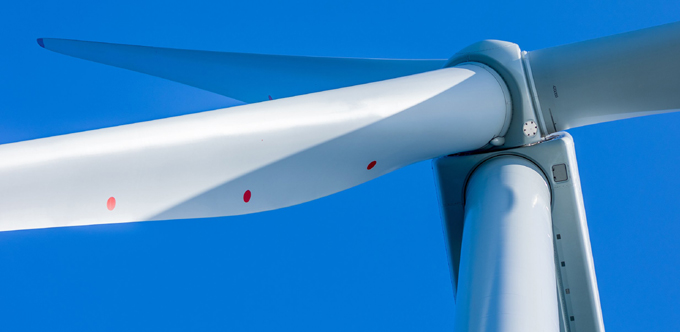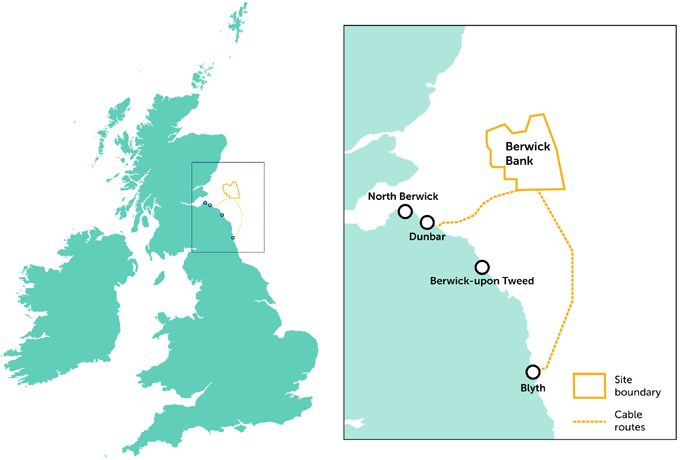
Located in the North Sea, in the outer Firth of Forth, the Berwick Bank Wind Farm has the potential to deliver up to 4.1 GW of installed capacity, making it one of the largest offshore opportunities in the world.
The project will be capable of generating enough clean, renewable energy to power over six million homes, the equivalent to all of Scotland’s households twice over. It could avoid eight million tonnes of carbon dioxide every year – similar to removing all of Scotland’s annual car emissions.
Berwick Bank Wind Farm is now at an advanced stage of development. In late 2022, a planning application was submitted to the Scottish Government seeking consent to develop and enter construction. If approved for delivery, Berwick Bank Wind Farm could increase Scotland’s overall renewable energy capacity by nearly 30%.
The Project has secured two connection points to the UK electricity grid. One in East Lothian and another in the Blyth area of Northumberland.

Project key facts
Up to 4.1GW installed capacity
The proposed installed capacity of Berwick Bank Wind Farm could be up to 4.1GW, making it one of the largest offshore opportunities in the world currently in development.
Multi-billion pound investment
Berwick Bank Wind Farm represents a huge opportunity to secure multi-billion-pound investment in the Scottish and UK supply chain.
Up to 6 million homes powered*
Berwick Bank Wind Farm could generate enough clean, renewable energy to power over 6 million homes*, equivalent to supplying all of Scotland’s households twice over.
Extensive aerial bird surveys
Aerial bird surveys have been conducted during the development of Berwick Bank. The enormous amount of data collected has enabled SSE Renewables to refine their proposals and put forward a more environmentally friendly design.
Essential to meeting net zero targets
In July 2025, SSE welcomed the Scottish Government’s decision to grant consent for the pivotal 4.1GW Berwick Bank offshore wind farm, located around 38km east of the Scottish Borders coastline, boosting Scotland’s net zero ambitions and the UK’s clean power mission.
Grid connection secured
The project has secured a grid connection at Branxton, near Torness, in East Lothian. A second grid connection will be required for the project, which has been determined as Blyth, Northumberland
*6 million homes powered per annum based on Typical Domestic Consumption Values (Medium Electricity Profile Class 1, 2,900kWh per household; OFGEM, January 2020), minimum projected 50% wind load factor, and projected installed capacity of up to 4.1GW. All homes in Scotland based on Household Estimates Scotland 2019 (National Records of Scotland, June 2020).
The wind farm infrastructure
The Berwick Bank Wind Farm requires both offshore and onshore infrastructure to generate and transmit electricity from the offshore wind farm to the National Grid.
The offshore components include:
- the offshore wind farm (the wind turbines, their foundations and associated inter-array cabling)
- the associated transmission infrastructure including Offshore Substation Platforms (OSPs)/Offshore convertor station platforms, their foundations, interconnector cables, offshore export cables and cable protection.
The onshore components (in both East Lothian and Northumberland) include:
- Onshore Export Cables
- an Onshore Converter Station and associated grid connection to both the a Scottish Power Energy Networks (SPEN) 400 kV Grid Substation in Branxton and the exiting National Grid Blyth substation in Northumberland.
There are two grid connection locations:
- In Scotland at Branxton, East Lothian, south west of the Torness Power station.
- In England at Cambois, just north of Blyth in Northumberland.
KeyFacts Energy: SSE UK country profile
 KEYFACT Energy
KEYFACT Energy